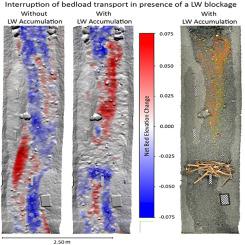Ecological Engineering ( IF 3.9 ) Pub Date : 2021-01-25 , DOI: 10.1016/j.ecoleng.2021.106156 Gabriel Spreitzer , Jon Tunnicliffe , Heide Friedrich

|
Large wood (LW) commonly forms log jams, influencing bed composition and biota via complex flow-sediment-wood interactions. A LW blockage, often induced by river-crossing infrastructure, can strongly alter channel hydraulics and sediment transport patterns, thus inducing a ‘forced’ channel morphology. For studying the deposition of bedload gravel fractions in the presence of a rigid LW jam, a novel experimental setup is presented. Using a mobile bed stream table, the effects of a channel-spanning blockage (a ‘dam jam’), resting at a bridge pier, on sediment transport and scour dynamics are examined. Changes in channel morphology were measured using Structure from Motion (SfM) photogrammetry and manually obtained bedload measurements. For the experiment without LW accumulation in place, natural bedload transport was observed over the entire channel length - about 20% of fed colour gravel was recovered from the sediment trap at the outlet, while a total bedload interruption occurred in presence of the LW accumulation, resulting in trapping all fed gravel material upstream of the obstructed cross-section. The volumetric deviation between SfM and manual measurements was less than 0,4%. The porosity characteristics of the LW accumulation were analysed using volumetric meshing techniques. With our experiments, we demonstrated that a relatively high log jam porosity has significant impact on channel morphology. By interrupting the hydraulic energy gradient, the movement of coarse sediment transport is damped, forcing deposition and initiating the development of a sediment wedge upstream of the infrastructure. Our quantitative results provide new insights into how LW can force channel morphology (particularly sediment storage) through the alteration of channel hydraulics. We further elaborate on how novel laboratory-based SfM techniques can be used to enhance the current understanding of complex flow-sediment-wood interaction processes at engineered in-stream structures.
中文翻译:

液压结构存在下大木材(LW)堵塞对床荷载连通性的影响
大型木材(LW)通常形成原木堵塞,通过复杂的流沙-木材相互作用影响床的组成和生物区系。LW堵塞通常是由跨河基础设施引起的,可以极大地改变河道的水力和沉积物的运输方式,从而导致“强迫”的河道形态。为了研究在存在刚性LW堵塞的情况下基岩碎石馏分的沉积,提出了一种新颖的实验装置。使用移动床流表,研究了在桥墩处搁置的跨河阻塞(“大坝堵塞”)对沉积物迁移和冲刷动力的影响。使用运动结构(SfM)摄影测量法测量通道形态的变化,并手动获得床载测量值。对于没有堆积轻水的实验,在整个通道长度上观察到了自然的床荷运输-从出口处的沉积物收集器中回收了约20%的进料彩色砾石,而在LW堆积的存在下发生了总的床load中断,导致将所有进料的砾石材料截留在上游横截面受阻。SfM和手动测量之间的体积偏差小于0.4%。LW堆积物的孔隙率特征使用体积网格技术进行了分析。通过我们的实验,我们证明了较高的原木堵塞孔隙率对通道形态具有重大影响。通过中断水力能量梯度,粗泥沙输送运动受到抑制,迫使沉积并启动基础设施上游泥沙楔的发育。我们的定量结果为LW如何通过改变通道水力来迫使通道形态(特别是沉积物存储)提供了新的见解。我们进一步阐述了如何使用新颖的基于实验室的SfM技术来增强当前对工程流结构中复杂的流-沉积-木材相互作用过程的了解。











































 京公网安备 11010802027423号
京公网安备 11010802027423号